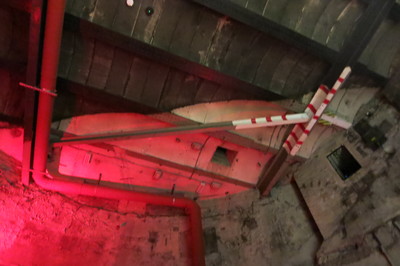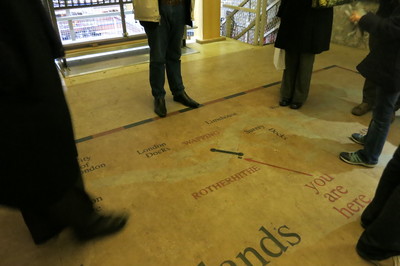 The Grand Entrance Hall is the last part of the once famous Thames Tunnel still accessible by the public (although, on the right tube train, you will travel along the Thames Tunnel) There isn't much to see, and there were disappointing piles of tat left over from a previous social event. Our guide gave a slightly scatty talk, making a few assumptions about how much we already knew about the Thames' Tunnel and The Grand Entrance Hall. A particularly curious tourist asked some questions which led to interesting information being imparted, and areas and directions being pointed out in situ, but without his probing, these facts would have been left uncalrified or wholly unmentioned. There are plenty of fascinating facts and personal tales to tell in this space, and a bit of help from a professional may help the volunteers in doing this, while still keeping it "their" tour. Our guide did treat us to a delightful piano solo, to demonstrate why the space is now ideal for music performances and parties since it's redevelopment. The roof garden is used to grow plants for making cocktails at regular museum social evenings, so they are certainly savvy about using appealing to seekers of unconventional events. Back in the Engine House, we all browsed around a very competently put together small exhibition, which it would probably benefit visitors to go through prior to visiting the Grand Entrance Hall. Seeing models of the construction of the tunnel, and images of the tunnel in use, helped put the Grand Entrance Hall into context. It also provided more details about the lives and work of Marc and Isambard Brunel, focusing on their work in and around London. There was some wear and tear, which could easily be solved with a bit of glue, but overall it surprised me in a positive way both for ambition, content, and results. As we left, I spotted benches outside created in the style of notable Brunel creations. As the Engine House and Grand Entrance Hall were both saved by local demand when threatened with redevelopment, the amount of Brunel visible outside the museum helps generate interest in the museum and the Brunels, as well as further demonstrating the local pride in their connection. The slightly unprofessional, but very warm and chatty staff, were actually a refreshing change from uniformed and helpful, but often time pressured and carefully schooled, staff at the big museums. Taking about and hour and a half at a London museum, but not feeling like our legs were walked off, or there was too much to process, was also welcome.
All in all, I feel The Brunel Musuem is well worth £6 a head, as you genuinely feel you are keeping a part of London history open and available and useful, and that they are also putting in an effort to fund and maintain it in novel ways rather than just relying on visitor income.
0 Comments
Leave a Reply. |
Webcomic and occasional blog about the heritage sector. Follow The Attendant:Topics
All
AuthorAll text and images are produced by and copyright of the artist, holder of the domain name of attendantsview.com Archives
February 2023
|


















 RSS Feed
RSS Feed
